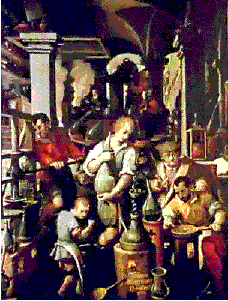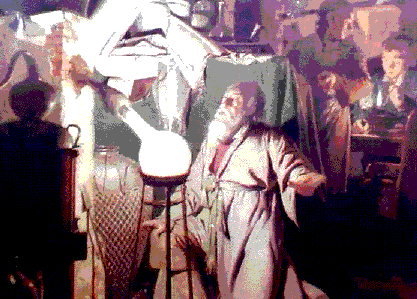
Alchemy is an ancient pseudo science concerned with the transmutation of base metals, the more reactive metals, into gold (see transmutation of elements) and with the discovery of both a single cure for all diseases and a way to prolong life indefinitely. Alchemy emerged as a pseudo science in China and in Egypt during the early centuries of this era.
In China it was associated with Taoist philosophy and purported to transmute base metals into gold by use of a "medicine." The gold so produced was thought to have the ability to cure diseases and to prolong life.
|
The mystical element was always strong in alchemy and became dominant with time so that alchemy in China degenerated into a complex of superstitions. In Egypt, the methods of transmutation of metals were kept secret by temple priests. Those recipes became widely known (2d century) at the academy in Alexandria. Alchemy had its basis in the skills of Egyptian artisans, Eastern mysticism, and Aristotelian theory of composition of matter. Aristotle taught that all matter was composed of four elements: water, earth, fire, and air. According to his theory, different materials found in nature had different ratios of these four elements. Therefore, by proper treatment a base metal could be changed into gold. These ideas were further supported by astrological speculations from Mesopotamia. Early Egyptians were masters of applied chemistry although much of it was closely linked to the embalming of bodies and religious rituals. Because of the very nature of the art of khemeia, it was shrouded in mystery and written in obscure symbolism. This symbolism, not unlike some modern chemical symbolism has its origins in the planets and the metals. Such names as silver nitrate stem from the old name "Lunar Caustic" showing its link to the moon. Similarly, the true ancient name for mercury is "hydrargyrum" meaning liquid silver. This is similar to the old English word for quicksilver. The problem with all this symbolism was that it severely retarded early chemical development. |
 |
One of the first important workers in Greek-Egyptian khemia was Bolos or Mendes (c. 200 B.C.) on the Nile Delta. He often referred to himself as Bolos-Democritus. Bolos devoted himself to the transmutation of lead or iron into gold. At this time they used a four element theory that suggested to them that substances only differed by the nature of their mixtures and that by altering the mixture, they could convert from one substance to another. After all, Ice could form water and water could form steam. Wood could be converted into fire and air and so on so it was logical (at that time to convert one metal into another metal).
During Roman times the art of khemeia faded into obscurity and even a 300 A.D. encyclopedia by the Egyptian born writer Zosimus contained very little new or novel information in it. The problem it seemed was that the Romans and in particular Emperor Diocletian who feared that among other things, converting lead into cheap gold might destroy the Empire. In addition to this the rise of Christianity removed a lot of the pagan learning about A.D. 400 in Alexandria during the Christian riots.
It was left to the Arabs to revive khemeia in the seventh century. Stimulated by the religion of Islam, founded by Mohammed, the Arab world grew rapidly conquering vast areas of western Asia and northern Africa before invading Egypt in A.D. 641 and then Persia. The Arabs were fascinated by the tradition of Greek Science and in A.D. 670 following their attempt to besiege Constantinople which was thwarted by "Greek Fire" turned their attentions to the Greek khemeia.
In Arabic, "khemeia" became "al-kimiya" the prefix for which means "the." This word was eventually adopted by the Europeans as alchemy and the people practicing alchemy were known as alchemists. The best of the Arabic alchemy was during their period of domination. Jabir ibn-Hayyan (c.715 - c. 815 A.D.), later known to the Europeans as "Geber" described ammonium chloride, acetic acid from vinegar and even prepared a weak form of nitric acid. His greatest influence however, lay in transmutation of metals. He believed that it was possible to take mercury and sulfur to produce different types of metals by mixing them in different proportions. It was held from then on that any transmuting substance was a dry powder and that it had great powers. The Arabic word for "dry" is "al-iksir" which was converted "elixir" by the Europeans and often referred to as "philosophers stone".
Al-Razi (c.850 - c.925) described the preparation of plaster of Paris and how it could be used to hold broken bones in place. He was also, more interested in medicine than previous Arabic alchemists and this was passed indirectly to his successor, Ibn Sina (979 - 1037) who was the most important physician between the Roman and modern scientific periods.
|
|
He had learned enough to doubt that transmutation of one metal to another was even possible even though other alchemists still believed it was possible, probably as a result of a desire to have large amounts of gold. After this period, Arabic science rapidly declined and after 3 centuries Arab dominated science, it passed to the Western world, never to return. The first real contact that the western world had with the world of Islam was through the Crusades. |
By about 1200 the European scholars were absorbing and advancing the Arabic alchemy. Albert of Bollstadt (c. 1200-80), also known as Albertus Magnus ("Albert the Great") studied many of the early works and received credit for his description of arsenic. Probably, an early example of plagiarism!!!! Alberts contemporary, the Monk and English scholar Roger Bacon (1214 - 92), is best known for developing mathematical techniques to science and proposed that the furtherment of science lay in this direction. Although, believed to be the discoverer of gunpowder, he simply described it. Its origin is unknown. Later developments of the Spanish scholars Arnold of Villanova (c. 1235-1311) and Raymond Lully (1235-1315) lay in more mystical areas and the revival of attempts at transmutation.
Ove the next two centuries, the Turks reclaimed Constantinople (1453), the coast of Africa was explored and rounded (1497) and Christopher Columbus discovered a new half of the world (1492 to 1504). This was the "Age of Exploration" during which time the printing press was invented in Germany by Johann Gutenberg, and the Polish Astronomer, Nicholas Copernicus (1473 - 1543) proposed that the earth was in fact not the center of the universe.
In 1597, the German alchemist Andreas Libau published Alchemia which summarized the medieval achievements of alchemy and is considered the first chemical text book of worth. He was also the first to describe hydrochloric acid and the preparation of aqua regia by mixing nitric and hydrochloric acids. Its name, aqua regia, meaning "royal water" gets its name from its ability to dissolve water.
By the end of the 17th century alchemy was dwindling in importance and would be replaced in the early 18th century by what we now call chemistry.
